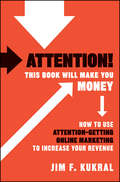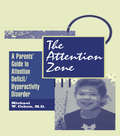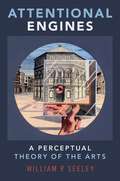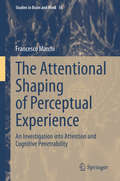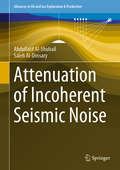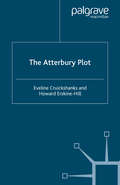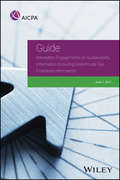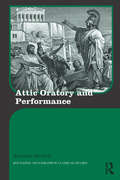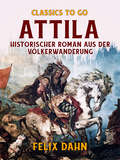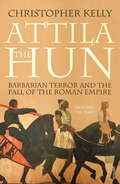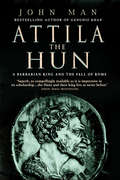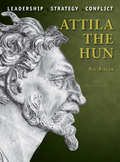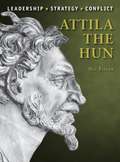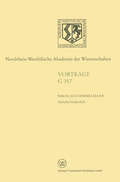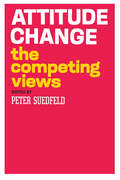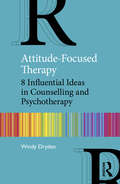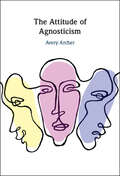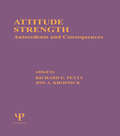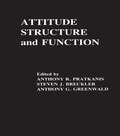- Table View
- List View
Attention! This Book Will Make You Money: How to Use Attention-Getting Online Marketing to Increase Your Revenue
by Jim F. KukralDrive Web traffic and take your business into the future In todays social Web marketplace, attention equals revenue. When you direct more attention online to your brand or business, you drive more long-term revenue. Regardless of who you are or how small your business is, you can have a huge impact using free Internet tools...provided you understand and correctly apply the latest techniques. Attention! gives you an educational and motivational guide to using social media to market your brand or business online. In three parts, you'll discover everything you need to know to get off the ground and thrive in the social mediasphere, including The tools, techniques and tricks to get attention online and turn that attention into profit The theory behind the importance of making your mark on the Internet How other businesses and individuals made money from online marketing Whether you're just starting your business, just moving it online, or already established and looking to take your business to the next level, Attention! is the key to success.
The Attention Zone: A Parent's Guide To Attention Deficit/Hyperactivity
by Michael CohenFirst published in 1998. Routledge is an imprint of Taylor & Francis, an informa company.
The Attention Zone: A Parent's Guide To Attention Deficit/Hyperactivity
by Michael CohenFirst published in 1998. Routledge is an imprint of Taylor & Francis, an informa company.
Attentional Engines: A Perceptual Theory of the Arts (Thinking Art)
by William P. SeeleyWhat is it about art that can be so captivating? How is it that we find value in the often odd and abstract objects and events we call artworks? William P. Seeley proposes that artworks are attentional engines. They are artifacts that have been intentionally designed to direct attention to critical stylistic features that reveal their point, purpose, or meaning. In developing this view, Seeley argues that there is a lot we can learn about the value of art from interdisciplinary research focused on our perceptual engagement with artworks. Recent breakthroughs in cognitive science and behavioral science can explain how we recognize artworks and how we differentiate them from more quotidian artifacts. Seeley pushes this line of reasoning, showing how cognitive science can help reveal the way artworks function as a unique source of value. He argues that our interactions with artworks draw on a broad base of shared artistic and cultural norms constitutive of different categories of art. Cognitive systems integrate this information into our experience of art, guiding attention and shaping what we perceive. Our understanding and appreciation of artworks is therefore carried in our perceptual experience of them. Attentional Engines explores the pitfalls and potential of this interdisciplinary strategy for understanding art. It articulates a cognitivist theory of art grounded in perceptual psychology and neuroscience and demonstrates its application to a range of puzzles in the philosophy of the arts. This includes questions about the nature of depiction, the role played by metakinesis in dance appreciation, the nature of musical expression, and the power of movies. The interdisciplinary and provocative theories Seeley presents will appeal to scholars and students interested in aesthetics, philosophy of mind, philosophy of art, and cognitive science.
ATTENTIONAL ENGINES TA C: A Perceptual Theory of the Arts (Thinking Art)
by William P. SeeleyWhat is it about art that can be so captivating? How is it that we find value in the often odd and abstract objects and events we call artworks? William P. Seeley proposes that artworks are attentional engines. They are artifacts that have been intentionally designed to direct attention to critical stylistic features that reveal their point, purpose, or meaning. In developing this view, Seeley argues that there is a lot we can learn about the value of art from interdisciplinary research focused on our perceptual engagement with artworks. Recent breakthroughs in cognitive science and behavioral science can explain how we recognize artworks and how we differentiate them from more quotidian artifacts. Seeley pushes this line of reasoning, showing how cognitive science can help reveal the way artworks function as a unique source of value. He argues that our interactions with artworks draw on a broad base of shared artistic and cultural norms constitutive of different categories of art. Cognitive systems integrate this information into our experience of art, guiding attention and shaping what we perceive. Our understanding and appreciation of artworks is therefore carried in our perceptual experience of them. Attentional Engines explores the pitfalls and potential of this interdisciplinary strategy for understanding art. It articulates a cognitivist theory of art grounded in perceptual psychology and neuroscience and demonstrates its application to a range of puzzles in the philosophy of the arts. This includes questions about the nature of depiction, the role played by metakinesis in dance appreciation, the nature of musical expression, and the power of movies. The interdisciplinary and provocative theories Seeley presents will appeal to scholars and students interested in aesthetics, philosophy of mind, philosophy of art, and cognitive science.
The Attentional Shaping of Perceptual Experience: An Investigation into Attention and Cognitive Penetrability (Studies in Brain and Mind #16)
by Francesco MarchiThis monograph presents a clear account of when and how attentional processes can shape perceptual experience. This argument is based on the prediction-error minimization model of the mind. The author believes that the topic of attention should take a more central role in the debate about the influence of cognition on perception. Inside, he shows how this can be possible.The hypothesis that cognition may shape perceptual experience has been traditionally labeled as the cognitive penetrability of perceptual experience. Cognitive penetrability is relevant for several debates in philosophy and cognitive science. It tackles the possibility of gathering genuine knowledge on the basis of perceptual information about the world delivered by sensory channels. The problem, the author notes, is that if our previously acquired belief can shape current perceptual experiences, such experiences cannot serve as an adequate source of justification in retaining those beliefs or even forming new ones. He argues that cognitive penetration may sometimes happen through attentional processes, but that its occurrence need not undermine perceptual justification.The book provides an overview of the cognitive penetrability debate. The author discusses evidence that supports the occurrence of this phenomenon. Overall, this investigation offers readers a philosophical discussion of attention based on the biased-competition theory. It argues that attention is a property of mental representations that emerges from a metacognitive competition process.
Attenuation of Incoherent Seismic Noise (Advances in Oil and Gas Exploration & Production)
by Abdullatif Al-Shuhail Saleh Al-DossaryThis book examines the effects of incoherent noise and how it leads to the misinterpretation of seismic data. It also reviews common noise reduction approaches and their drawbacks, focusing on developments that have occurred in the past decade. The main features of this book include: • Hands-on implementation in MATLAB and/or C • In-depth discussions of both theoretical and practical aspects of the subject • Supplementary, real-world seismic data • Detailed descriptions of structure-enhancing filters. Connecting the theory and practical implementation of noise reduction, the book helps readers fill the gap from equations to code, and from classical filters to the preservation and enhancement of a robust structure. Lastly, it highlights cutting-edge research in the area. As such, it is of interest to researchers in the fields of petroleum engineering, exploration seismology, and geophysics, as well as to practitioners working in the petroleum industry.
The Atterbury Plot (Studies in Modern History)
by E. Cruickshanks H. Erskine-HillRobert Walpole foiled the Atterbury Plot by preventive arrests and holding those he suspected illegally without bail or trial. When Parliament met and the Habeas Corpus Act was suspended, he used show trials, decided by votes along party lines and depending on forged evidence, to curb the Tory party, to reuinted the Whig party and to consolidate his hold on power. Rich in new material, this book unravels for the first time the scale and international dimension of a plot which posed the most serious challenge to the Hanoverian regime before the '45 rebellion.
Attestation Engagements on Sustainability Information (AICPA)
by AICPANew Authoritative Guide for SSAE No. 18 and Sustainability Organizations are increasingly seeking to add credibility to sustainability information: According to the CFA Institute, 73 percent of portfolio managers and research analysts surveyed take sustainability matters into account when making investment decisions and 69 percent believe it is important that such information be subject to independent assurance. This new guide will assist CPAs with interpreting and applying the clarified attestation standards (SSAE No. 18) when performing examination or review engagements on sustainability information. Note: This guide supersedes AICPA Statement of Position (SOP) 13-1, Attest Engagements on Greenhouse Gas Emissions Information. The content of that SOP has been updated for the clarified attestations standards and included in the guide.
Attic Oratory and Performance (Routledge Monographs in Classical Studies)
by Andreas SerafimIn a society where public speech was integral to the decision-making process, and where all affairs pertaining to the community were the subject of democratic debate, the communication between the speaker and his audience in the public forum, whether the law-court or the Assembly, cannot be separated from the notion of performance. Attic Oratory and Performance seeks to make modern Performance Studies productive for, and so make a significant contribution to, the understanding of Greek oratory. Although quite a lot of ink has been spilt over the performance dimension of oratory, the focus of nearly all of the scholarship in this area has been relatively narrow, understanding performance as only encompassing 'delivery' – the use of gestures and vocal ploys – and the convergences and divergences between oratory and theatre. Serafim seeks to move beyond this relatively narrow focus to offer a holistic perspective on performance and oratory. Using examples from selected forensic speeches, in particular four interconnected speeches by Aeschines (2, 3) and Demosthenes (18, 19), he argues that oratorical performance encompassed subtle communication between the speaker and the audience beyond mere delivery, and that the surviving texts offer numerous glimpses of the performative dimension of these speeches, and their links to contemporary theatre.
Attic Oratory and Performance (Routledge Monographs in Classical Studies)
by Andreas SerafimIn a society where public speech was integral to the decision-making process, and where all affairs pertaining to the community were the subject of democratic debate, the communication between the speaker and his audience in the public forum, whether the law-court or the Assembly, cannot be separated from the notion of performance. Attic Oratory and Performance seeks to make modern Performance Studies productive for, and so make a significant contribution to, the understanding of Greek oratory. Although quite a lot of ink has been spilt over the performance dimension of oratory, the focus of nearly all of the scholarship in this area has been relatively narrow, understanding performance as only encompassing 'delivery' – the use of gestures and vocal ploys – and the convergences and divergences between oratory and theatre. Serafim seeks to move beyond this relatively narrow focus to offer a holistic perspective on performance and oratory. Using examples from selected forensic speeches, in particular four interconnected speeches by Aeschines (2, 3) and Demosthenes (18, 19), he argues that oratorical performance encompassed subtle communication between the speaker and the audience beyond mere delivery, and that the surviving texts offer numerous glimpses of the performative dimension of these speeches, and their links to contemporary theatre.
Attila Historischer Roman aus der Völkerwanderung (Classics To Go)
by Felix DahnAttila († 453) war von 434 (als Mitherrscher zusammen mit seinem Bruder Bleda) bzw. 444/45 (als Alleinherrscher) bis zu seinem Tod „König“ (rex) des Kriegerverbandes der Hunnen. Zentrum seines Machtbereichs war das Gebiet des heutigen Ungarns, wo die Hunnen im 5. Jahrhundert ein kurzlebiges Reich errichteten, das unter Attila die größte Machtentfaltung erlebte, aber bereits kurz nach seinem Tod wieder zusammenbrach. (Wikipedia)
Attila The Hun: Barbarian Terror and the Fall of the Roman Empire
by Christopher KellyAttila the Hun - godless barbarian and near-mythical warrior king - has become a byword for mindless ferocity. His brutal attacks smashed through the frontiers of the Roman empire in a savage wave of death and destruction. His reign of terror shattered an imperial world that had been securely unified by the conquests of Julius Caesar five centuries before. This book goes in search of the real Attila the Hun. For the first time it reveals the history of an astute politician and first-rate military commander who brilliantly exploited the strengths and weaknesses of the Roman empire. We ride with Attila and the Huns from the windswept steppes of Kazakhstan to the opulent city of Constantinople, from the Great Hungarian Plain to the fertile fields of Champagne in France. Challenging our own ideas about barbarians and Romans, imperialism and civilisation, terrorists and superpowers, this is the absorbing story of an extraordinary and complex individual who helped to bring down an empire and forced the map of Europe to be redrawn forever.
Attila The Hun: A Barbarian King And The Fall Of Rome
by John ManThe name Attila the Hun has become a byword for barbarism, savagery and violence. His is a truly household name, but what do we really know about the man himself, his position in history and the world in which he lived? This riveting biography reveals the man behind the myth.In the years 434-454AD the fate of Europe hung upon the actions of one man, Attila, king of the Huns. The decaying Roman empire still stood astride the Western World, from its twin capitals of Rome and Constantinople, but it was threatened by a new force, the much-feared Barbarian hordes. It was Attila who united the Barbarian tribes into a single, amazingly-effective army. He launched two violent attacks against the eastern and western halves of the Roman empire, attacks which earned him his reputation for mindless devastation, and brought an end to Rome's pre-eminence in Europe.Attila was coarse, capricious, arrogant, ruthless and brilliant. An illiterate and predatory tribal chief, he had no interest in administration, but was a wily politician, who, from his base in the grasslands of Hungary, used secretaries and ambassadors to bring him intelligence on his enemies. He was a leader whose unique qualities made him supreme among tribal leaders, but whose weaknesses ensured the collapse of his empire after his death.
Attila the Hun (Command #31)
by Nic Fields Mr Steve NoonOne of the most powerful men in late antiquity, Attila's peerless Hunnic empire stretched from the Ural mountains to the Rhine river. In a series of epic campaigns dating from the AD 430s until his death in AD 453, he ravaged first the Eastern and later the Western Roman Empire, invading Italy in AD 452 and threatening Rome itself. Lavishly illustrated, this new analysis of his military achievements examines how Attila was able to sweep across Europe, the tactics and innovations he employed and the major battles he faced, including one of his few major setbacks, the defeat at the battle of the Catalaunian Fields in AD 451.
Attila the Hun (Command)
by Nic Fields Steve NoonOne of the most powerful men in late antiquity, Attila's peerless Hunnic empire stretched from the Ural mountains to the Rhine river. In a series of epic campaigns dating from the AD 430s until his death in AD 453, he ravaged first the Eastern and later the Western Roman Empire, invading Italy in AD 452 and threatening Rome itself. Lavishly illustrated, this new analysis of his military achievements examines how Attila was able to sweep across Europe, the tactics and innovations he employed and the major battles he faced, including one of his few major setbacks, the defeat at the battle of the Catalaunian Fields in AD 451.
Attische Grabreliefs (Nordrhein-Westfälische Akademie der Wissenschaften #357)
by Nikolaus HimmelmannAttitude Change: The Competing Views
by Anton PelinkaWhat are attitudes and how are they modified? The many opposing theories to answer this question reflects not only the complexity but also the importance of the field. A central concern of social psychology, attitude change is also relevant to the study of human behavior in general, and a matter of major significance to the world outside the laboratory. Valid and useful theories of attitude change are thus of far-reaching consequence. At the same time, the richness and flexibility of attitude structures and the numerous methodological problems involved in studying them make the development of a definitive theory difficult, if not impossible. For these reasons many explanations have been offered but none have been greatly accepted.The essays included here give voice to a broad sampling of these competing viewpoints. For years attention has been directed mostly to the individual's need to maintain harmony within him, and several of the authors focus on this concept. Cognitive dissonance theory is evaluated in particular detail. Ideas derived from other areas of psychology and attitude change theories based on learning, perception, and cognitive motivation are also well represented in this volume.In his introduction, Suedfeld evaluates these major approaches as well as several less well-known alternatives. In weighing the strengths and weaknesses of each system he considers the limits of the applications of the various theories and the problems the theorists face. This book will be welcomed in a variety of undergraduate and graduate courses, and by scholars and educated laymen seeking information on the current state of knowledge in this field.
Attitude Change: The Competing Views (Controversy Ser.)
by Peter SuedfeldWhat are attitudes and how are they modified? The many opposing theories to answer this question reflects not only the complexity but also the importance of the field. A central concern of social psychology, attitude change is also relevant to the study of human behavior in general, and a matter of major significance to the world outside the laboratory. Valid and useful theories of attitude change are thus of far-reaching consequence. At the same time, the richness and flexibility of attitude structures and the numerous methodological problems involved in studying them make the development of a definitive theory difficult, if not impossible. For these reasons many explanations have been offered but none have been greatly accepted.The essays included here give voice to a broad sampling of these competing viewpoints. For years attention has been directed mostly to the individual's need to maintain harmony within him, and several of the authors focus on this concept. Cognitive dissonance theory is evaluated in particular detail. Ideas derived from other areas of psychology and attitude change theories based on learning, perception, and cognitive motivation are also well represented in this volume.In his introduction, Suedfeld evaluates these major approaches as well as several less well-known alternatives. In weighing the strengths and weaknesses of each system he considers the limits of the applications of the various theories and the problems the theorists face. This book will be welcomed in a variety of undergraduate and graduate courses, and by scholars and educated laymen seeking information on the current state of knowledge in this field.
Attitude-Focused Therapy: 8 Influential Ideas in Counselling and Psychotherapy
by Windy DrydenIn this book, Windy Dryden selects the eight ideas that have had the most influence on him in his career as a psychotherapist, and which form the bedrock of his work. These ideas reflect both his specific and his general interests in the field. The book offers insight into the author's practice and the theories that have informed his work in a therapeutic setting. It discusses the role that attitudes play in psychologically disturbed and psychologically healthy responses to life’s adversities. The book also elaborates the author’s views on what promotes psychological change as well as why he considers the concepts of responsibility and choice to be so important in psychotherapy. Finally, the book highlights Windy Dryden’s more recent work in the field of single-session therapy. This accessible and engaging book will be a fascinating read for counsellors and psychotherapists, both in training and practice.
Attitude-Focused Therapy: 8 Influential Ideas in Counselling and Psychotherapy
by Windy DrydenIn this book, Windy Dryden selects the eight ideas that have had the most influence on him in his career as a psychotherapist, and which form the bedrock of his work. These ideas reflect both his specific and his general interests in the field. The book offers insight into the author's practice and the theories that have informed his work in a therapeutic setting. It discusses the role that attitudes play in psychologically disturbed and psychologically healthy responses to life’s adversities. The book also elaborates the author’s views on what promotes psychological change as well as why he considers the concepts of responsibility and choice to be so important in psychotherapy. Finally, the book highlights Windy Dryden’s more recent work in the field of single-session therapy. This accessible and engaging book will be a fascinating read for counsellors and psychotherapists, both in training and practice.
The Attitude of Agnosticism
by null Avery ArcherWe often describe ourselves as agnostic on a wide range of topics, such as does God exist, is String Theory true, or will the President win re-election? But what, precisely, does it mean to be agnostic? This monograph employs the tools and techniques of analytic philosophy to offer a broad account of what it means to be agnostic in both theological and non-theological contexts, and offers a critical discussion of the major descriptive accounts of agnosticism in the contemporary analytic philosophical literature. Unlike most other volumes on the subject, which approach the question from a theological point of view, this is the first book-length discussion of agnosticism from a purely philosophical, as opposed to theological, point of view. It serves as a natural starting-point for students and specialists in philosophy and anyone who is interested in the topic of agnosticism through the lens of analytic philosophy.
Attitude Strength: Antecedents and Consequences
by Richard E. Petty Jon A. KrosnickSocial psychologists have long recognized the possibility that attitudes might differ from one another in terms of their strength, but only recently had the profound implications of this view been explored. Yet because investigators in the area were pursuing interesting but independent programs of research exploring different aspects of strength, there was little articulation of assumptions underlying the work, and little effort to establish a common research agenda. The goals of this book are to highlight these assumptions, to review the discoveries this work has produced, and to suggest directions for future work in the area. The chapter authors include individuals who have made significant contributions to the published literature and represent a diversity of perspectives on the topic. In addition to providing an overview of the broad area of attitude strength, particular chapters deal in depth with specific features of attitudes related to strength and integrate the diverse bodies of relevant theory and empirical evidence. The book will be of interest to graduate students initiating work on attitudes as well as to longstanding scholars in the field. Because of the many potential directions for application of work on attitude strength to amelioration of social problems, the book will be valuable to scholars in various applied disciplines such as political science, marketing, sociology, public opinion, and others studying attitudinal phenomena.
Attitude Strength: Antecedents and Consequences (Ohio State University Volume On Attitudes And Persuasion Ser. #Vol. 4)
by Richard E. Petty Jon A. KrosnickSocial psychologists have long recognized the possibility that attitudes might differ from one another in terms of their strength, but only recently had the profound implications of this view been explored. Yet because investigators in the area were pursuing interesting but independent programs of research exploring different aspects of strength, there was little articulation of assumptions underlying the work, and little effort to establish a common research agenda. The goals of this book are to highlight these assumptions, to review the discoveries this work has produced, and to suggest directions for future work in the area. The chapter authors include individuals who have made significant contributions to the published literature and represent a diversity of perspectives on the topic. In addition to providing an overview of the broad area of attitude strength, particular chapters deal in depth with specific features of attitudes related to strength and integrate the diverse bodies of relevant theory and empirical evidence. The book will be of interest to graduate students initiating work on attitudes as well as to longstanding scholars in the field. Because of the many potential directions for application of work on attitude strength to amelioration of social problems, the book will be valuable to scholars in various applied disciplines such as political science, marketing, sociology, public opinion, and others studying attitudinal phenomena.
Attitude Structure and Function
by Anthony R. Pratkanis Steven J. Breckler Anthony G. GreenwaldUtilizing "new wave" research including new psychological theories, new statistical techniques, and a stronger methodology, this collection unites a diversity of recent research perspectives on attitudes and the psychological functions of an attitude. The objective of the editors was to bring together the bits and pieces of validated data into one systematic and adequate set of general principles leading to the view of attitudes as predictions. As the volume reformulates old concepts, explores new angles, and seeks a relationship among various sub-areas, it also shows improvements in the sophistication of research designs and methodologies, the specifications of variables, and the precision in defining concepts.
